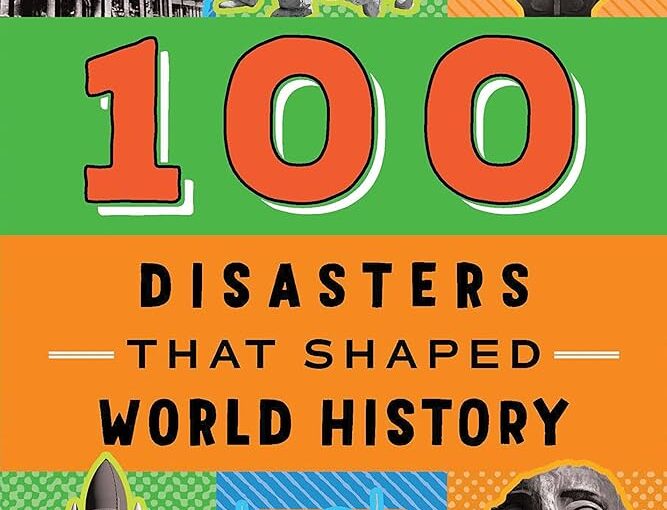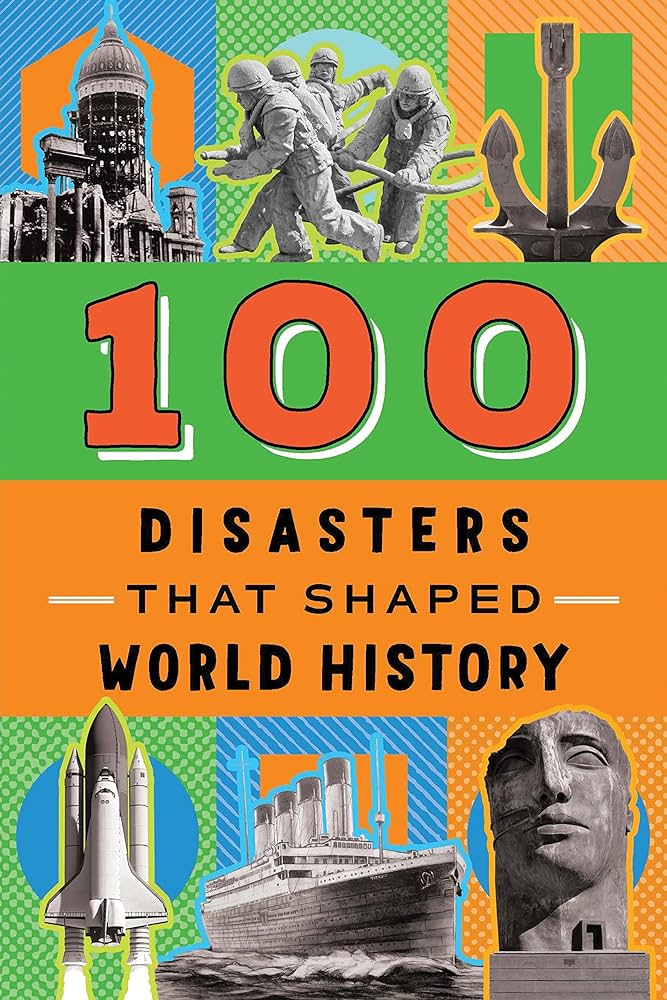I know that there’s a fish called the snotnose blobfish, I’ve read dozens of elementary school essays about them. Kids want to be the first ones in their group to know something or state unique facts. 100 Disasters That Shaped World History is a non-fiction, age-appropriate, reference book on events that have mainly happened in recent history that still resonate with people or cultures today. It’s a very smart book that’ll introduce events that they might’ve heard about directly, but have certainly heard about through comparative events.
During the height of COVID for example there were news reports comparing it to the Spanish Flu in 1918. Similar to COVID, that outbreak, which occurred simultaneous to WWI, killed between 20-40 million people around the world. It’s an event that I had certainly heard about but knew very little about the specifics. There’s a page in 100 Disasters That Shaped World History about this flu that’ll let upper elementary through middle school readers know that what they just experienced, while horrible, was very similar to what happened just over 100 years ago.
As an older reader, what I found surprising about the book was how many big-scale disasters I didn’t know about or had forgotten. If kids have visited New York City they might’ve heard about the fire onboard the General Slocum in 1904 which is the city’s deadliest maritime disaster. The potato famine in Ireland is on that I had always heard of as a historical side note, never really knew the massive scale of its impact.
The Oklahoma City bombing killed 167 people, and perhaps as surprising, its culprit was executed only six years later in 2001. The Mexico City earthquake in 1985 killed 9,500 people. In 1970 the Bhola Cyclone slammed into East Pakistan, which is now Bangledesh and killed around 300,000. It’s stunning to fathom that large of a figure, but it was a factor of people now evacuating, poor housing construction, and population density.
That storm hit in the middle of the night. The area had been evacuated a couple of weeks earlier for another storm that didn’t pan out to be as bad as predicted. Thus, when they were warned about this storm, many didn’t heed the warnings. The result was thousands of bodies in the water, which contaminated drinking water and caused a second sick wave of cholera or typhoid. When officials were trying to tally the total number of victims they found it easier and more effective to count the living than the dead.
Thankfully, not all of the stories in 100 Disasters That Shaped World History are on that large of a scale. However, each of the stories has an angle that merits its mention as something that is notable in the global scheme of thought. It’s not just a book on western disasters, it’s a globe-trotting look through history of man-made or natural disasters that kids will (hopefully) read or hear about at some point in middle school.
It’s also a very curious book that aligns with the Nat Geo Kids or cat video test in that, you can’t read (or watch) only one. The length of each story will take the average sixth-grade student about five minutes to consume. Granted, that’s assuming that the reader is really invested in the story. If their attention wanes then all they’ll have to do is thumb forward or backward to any page and find something that’s equally as interesting. This is not the literary equivalent to morbid tourism. The stories are treated with intelligence and historical accuracy that doesn’t play up or sensationalize each respective tragedy.
Kids want to be the first ones in their group to know something or state a unique fact. Yes, it’s a sometimes annoying trait that’s been amplified and confused by YouTube. However, the facts have somehow gotten more useless or random, in addition to being suspect in their accuracy. 100 Disasters That Shaped World History is fact-based; yet still entertaining, overview that introduces kids to situations that changed events globally. It might be challenging to get kids to realize that everything is not always about them, and these 100 instances of history just might do the trick through its macro and micro appeal.
100 Disasters That Shaped World History is Joanne Mattern and is available on Sourcebooks eXplore, an imprint of Sourcebooks Kids.
There are affiliate links in this post.






 Facebook
Facebook Twitter
Twitter Flickr
Flickr GooglePlus
GooglePlus Youtube
Youtube